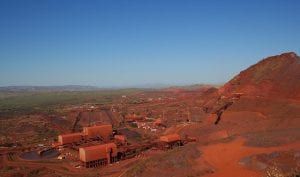If you want to know what the future holds for large-scale renewable energy development, take a look at Chile. That is a rough summary of what Origin Energy chief Grant King told a media briefing at the utility’s results announcement last week, while talking up the prospects of large-scale solar in Australia.
According to King, Chile is “where the prospectors are” – that is, energy company project developers lining up big solar project sites – including Origin, which has a 40 per cent share in a 69MW solar project in Chile, and bought the rights to develop a 280MW project in northern Chile.

Indeed, according to Bloomberg data, developers from around the world, led by SunEdison and Enel Green Power, have invested $US2 billion in Chile’s clean-energy industry in the first half of the year, more than double the pace of the same period a year ago.
And they’re investing there, says King, because it is “at the leading edge of large-scale solar, in terms of costs and deployment.”
So what is Chile doing right?
Currently, it has a national renewable energy target of 20 per cent by 2025 – and could certainly afford to aim higher. A study released on Wednesday by the NewClimate Institute finds that by shifting to 100 renewables by 2050 could save Chile $5.3 billion a year on fossil fuels, 1,500 lives a year due to reduced air-pollution in the capital, Santiago, alone, and create 11,000 new jobs.
But in many other ways, the Latin America nation offers a prime example – not least of all for Australia – of what can be achieved through effective policy and compelling economics; as well as with what SunPower CEO Tom Werner has described as “phenomenal sunshine.”
Since setting the country’s RET, the Chilean government has taken steps to liberalise its energy market, allowing solar and wind suppliers to sell power in favourable time blocks – a measure designed to boost the addition of intermittent power sources on to the grid.
It has also used energy auctions to loosen up the market, allowing generators to compete for contracts to deliver electricity under long-term agreements.
As Bloomberg reports, 10 companies including SunEdison, Acciona and Abengoa have already won contracts in the Chile auctions since their introduction in December, and are working on power plants that will supply at least 1GW of solar and wind power, about the same as a nuclear reactor.
The next tender, which is open to bids until April 2016, is designed to allocate 29 per cent of Chile’s regulated energy supply for the next decade.
Before the auctions, however, it was Chile’s energy-hungry resources industry, which also happened to be shouldering some of the world’s highest energy costs (three times more than the OECD average), that drove the nation’s renewables market.
State-owned Codelco copper mine, for example, in Chile’s Atacama desert, is now 80 per cent powered by a solar thermal plant run by Chile’s Energia Llaima and Denmark’s Arcon-Sunmark, which has replaced most of the 67,000 barrels of diesel it once consumed.
US-based SunPower, meanwhile, will kick off its $1.5 billion, 1GW development plans for Chile with the construction, later this year, of a 100MW solar farm in the country’s central region, to help meet the power needs of some of the large mining operations that exist nearby.
The scale of what is happening in Chile is currently unique in the world,” said Mike Elliott, head mining analyst at Ernst & Young. “It’s occurring in Chile because the economics just make sense.”
Ernst & Young recently estimated that mines in Latin America would collectively invest more than $US1 billion in renewable energy projects by 2022, up from $37 million in 2013.
Another report, released this week by THEnergy and mining analysts Cronimet, has estimated that mining projects that integrate solar PV generation can achieve typical cost savings in the range of 25-30 per cent, or more than 70 per cent for those mines in remote locations, which are not connected to the grid, and are thus exposed to elevated diesel prices.








